On a trip to Rocky Mountain National Park a few years ago, we couldn't go to one of the lakes we'd planned to visit. Too many visitors were already at that location in the park, and an electronic sign turned additional visitors - including us - away. At the time, we joked, "Nature is full!"
It happened again during our retirement trip. We had planned to visit Arches National Park. And even though we were there by 8:15, the electronic sign said that it was full. No more vehicles could enter the park for at least 4 to 5 hours.
Nature was full AGAIN. This time, we went for Plan B - the Canyonlands National Park. And, as it turned out, we went to Arches the next morning before sunrise, and it turned out to be even better anyway. (More on that to come.)
But even Canyonlands required a wait, as we found when we arrived. I took a photo of this sign, but we also went by one that prophesied a 1-hour wait. So we listened to our audio book ... and we waited. We had planned our trip for October, thinking summer crowds would have cleared out. I'm sure the crowds were less, but evidently, other people had the same idea we did! We were also hoping for more moderate weather, and it was better than it would have been during the summertime heat in the desert climate.
Canyonlands is part of a region called the Colorado Plateau, an area that stands high above the surrounding country. At first, that was confusing to me, since it's in Utah, but the Colorado Plateau doesn't mean Colorado, the state. About 20 million years ago, movement in the Earth's crust began to alter the landscape of North America, building modern landforms like the Rocky Mountains, Nevada's Basin and Range, and the Colorado Plateau. Some geologists believe that the plateau has risen as much as 10,000 feet since the uplift began.
As a side note, I couldn't resist buying a children's book, Scout Moore Junior Ranger on the Colorado Plateau.
For one, Moore is my maiden name. And I figured it could double as a gift for Kinley and Brooke. (That wasn't the only souvenir for them - or us.)
On the Colorado Plateau, water and gravity are the region's prime architects, and those elements cut flat layers of sedimentary rock into hundreds of canyons, mesas, buttes, fins, arches and spires.
Canyonlands is one of the U.S.'s more recent national parks. It was established in 1964. Up until that point, the remote area in southeastern Utah was largely unexplored - except for Native Americans, cowboys, river explorers and uranium prospectors.
However, it's proximity to Arches and other natural wonders makes it a destination these days for tourists like us. Desert mesas plunge thousands of feet into canyon webs.
Just like many of the national parks we toured this fall, we could have seen more of it had we taken our Jeep off road.
 | ||
| You
can see one of the roads in this photo. | |
 |
| However, there were also plenty that hugged the cliffs and would have required one-way traffic, while balancing on the edge, like in this photo. We opted no! |
We also didn't choose to explore via glider, like a couple of other people we saw!
And, just like with Mesa Verde and most other destinations on this trip, we didn't hike long distances, so we didn't explore every corner. But the overlooks still gave us a glimpse at the stark beauty.
Like other national parks in the area, Canyonlands pays tribute to the Ancestral Puebloans and the Fremont people, forebearers of the Ute, Paiute and Navajo tribes.
 |
| Upheaval Rock, Canyonlands |
In May 1869, Major John Wesley Powell set on on a mission to explore the uncharted canyons and waters of the Green and Colorado Ricers. Powell, a geology professor and Civil War veteran, began the journey with nine novice oarsmen and four wooden boats. He ended the journey three months later with two boats, six men and new knowledge of a unique landscape.
As they entered the wilds of the canyon country, Powell wrote in his journal, "What shall we find?" When Powell's party reached this section of the river, he described a "strange, weird, grand region of naked rock with cathedral-shaped buttes, towering hundreds or thousands of feet, cliffs that cannot be scaled and canyon walls that shrink the river into insignificance."
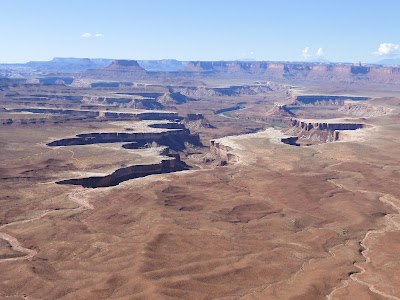 |
| You can see the river in the upper right quadrant of this photo that I took using my telephoto lens. |
With even more telephoto power, we could actually see some green along the river.
The Green River begins in the Wind River Range of Wyoming and joins the Colorado River 20 miles below this point at the confluence.
 |
| This was at Grand View Point. |
You can take the farmers off the farm, but we still notice things like signs for cattle crossings.
I'm guessing more people ask about bighorn sheep when visiting the ranger stations, but I asked about how many cattle were grazing the Canyonlands. The first ranger said, "a whole lot." The other ranger said around 200. We didn't see any of them, though that's not surprising, considering the national park encompasses 337,598 acres. (Everything is relative, I suppose, but 200 cattle didn't seem like "a whole lot" to us.)
While there was vegetation along portions of the plateau and mesa, today's landscape is one of erosion. The Green and Colorado Rivers began carving into the geologic layers, exposing buried sediments and creating the canyons of Canyonlands.
However, the rivers aren't the only force of erosion. Summer thunderstorms bring heavy rains to the landscape. Some layers erode more easily than others. As softer rock dissolves away, layers of harder rock form exposed shelves, giving the canyon walls their stair-step appearance. Occasionally, a slab of harder rock will protect a weaker layer under it, creating balanced rocks and towers.
Island in the Sky is the Canyonlands' observation tower. On a clear day, it can provide a glimpse of three mountain ranges - the La Sals, the Abajos and the Henrys.











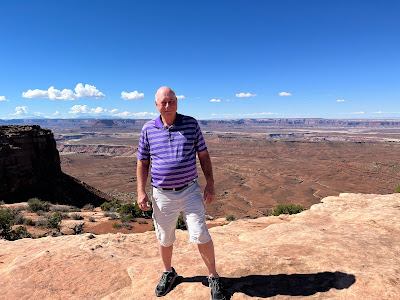

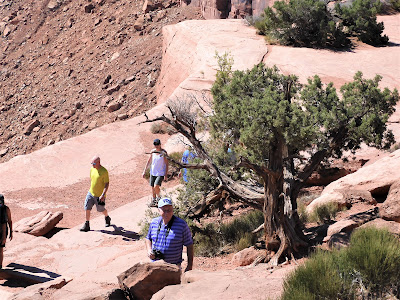








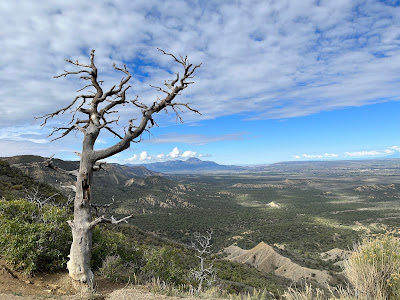


.jpg)
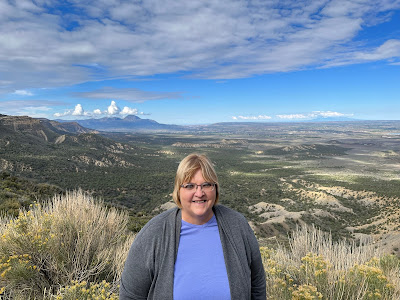







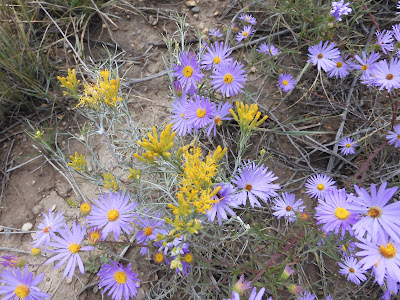


.jpg)

.jpg)
.jpg)




